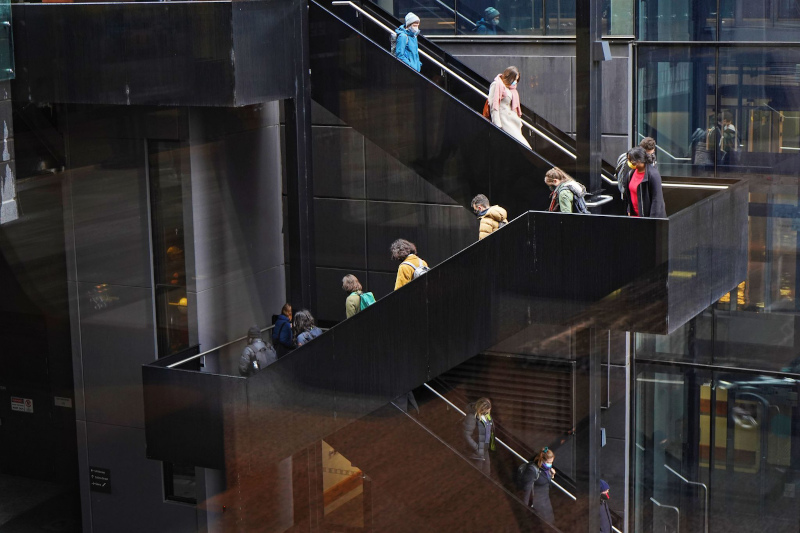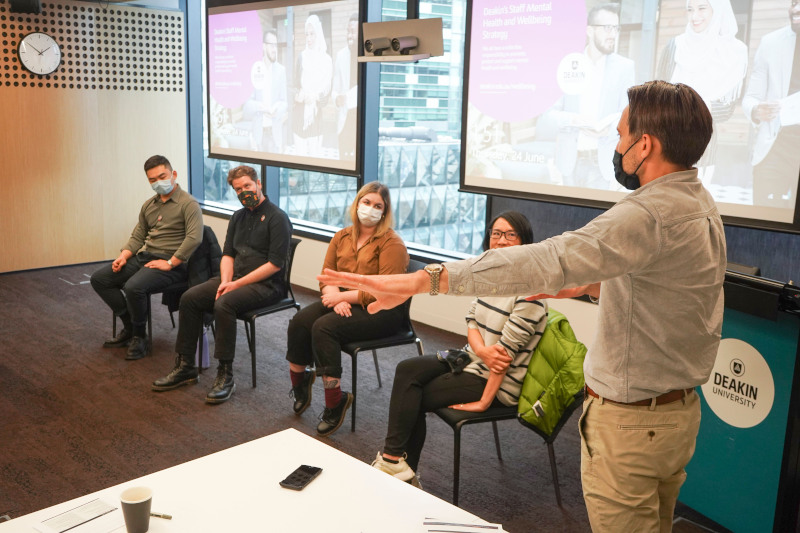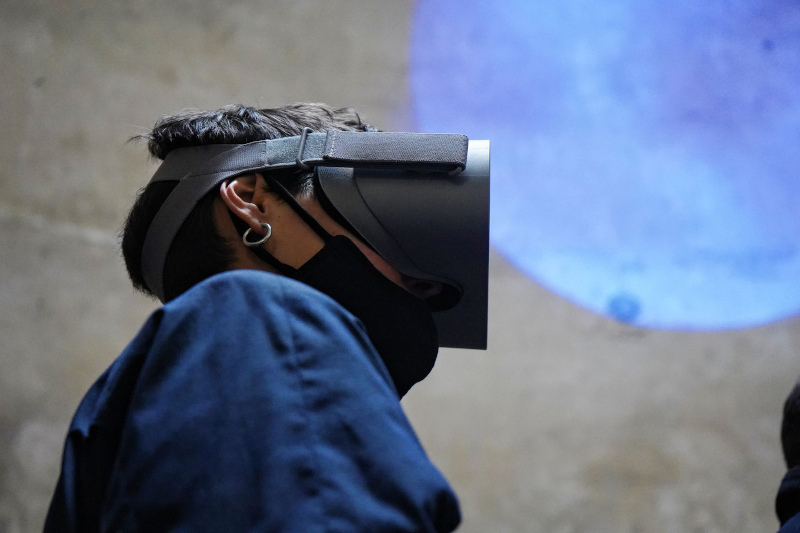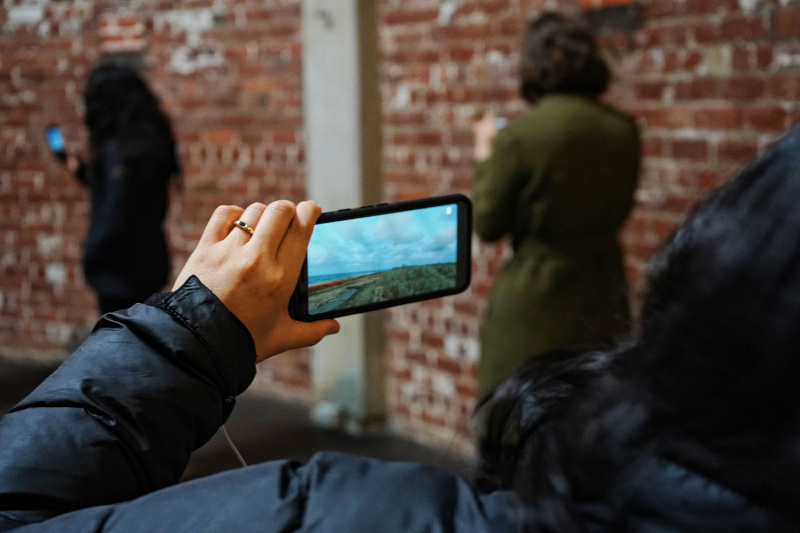
Workshop participants on a sound walk through downtown Melbourne. Credit: Giles Campbell-Wright
The 2021 AusSTS interdisciplinary workshop, hosted by the Deakin University Science & Society Network, was a two-day multi-sited event, bringing together STS researchers from across Australia and Aotearoa/New Zealand. Based on the theme of ‘Situated Practice’, the workshop combined keynote talks, thematic presentations by postgraduate and early career researchers, and field trips.
For a Melbourne-based postgraduate student, this workshop was a good opportunity to reflect on situated practices within my topic of pollinator conservation in cities. I’ve had the privilege to continue my fieldwork during 2021, which has not been the case for many attending the workshop. International research projects have been adapted to an online interface and COVID-safe practices now dictate the interactions with participants and spaces at the domestic level. It was also a good opportunity to see where my work is ‘situated’ within the STS community, as I transition from the environmental sciences to the humanities.
The workshop was the first face-to-face event for many of us to present research and network with peers in over 18 months, and the continued unpredictability of COVID-19 resulted in the Sydney and Wellington workshop hubs going virtual due to lockdowns. Darwin and Melbourne moved forward as planned with facemasks and altered field trips, reminders that the pandemic holds an atmosphere of caution over the multi-day event.
Arriving at the event, I realised that my social interactions in an academic context have been non-existent for some time. Prior to 2020, on-campus students such as myself would watch regular lunchtime talks and attend reading groups. Transitioning to researching from home was challenging and the shift back to in-person events feels strangely surreal.
As everyone helped themselves to a hot beverage and socially distanced themselves within the conference room, Day 1 of the conference commenced with Michelle Murphy (University of Toronto) delivering the keynote entitled Pollution, Colonialism & Rethinking Chemicals, which was live-streamed to begin the multi-sited and trans-Tasman workshop. Thematically focusing on relationships between chemical industries, pollution, and Indigenous peoples in what is commonly known as Canada, Murphy constructed a narrative around place-based relations on Indigenous land where many worlds exist and where many worlds might fit. Pollution, Murphy emphasises, is a continued legacy of colonialism and violence against Indigenous peoples and their lands, with bodies and land inseparable.
Murphy answered questions from workshop attendees in relation to the Keynote seminar, highlighting the importance of kinship in their scholarly work, and placing an emphasis to bring infrastructure into responsibility with First Nations communities and others. Aggregating important but sometimes disconnected research areas resonated strongly with many of those attending the workshops. Australia, as with Canada, is a settler-colonial state, with Traditional Owners actively resisting extractive industries on their ancestral lands. Murphy’s insights resonated strongly with some contemporary land rights movements in Australian, notably the resistance to the Carmichael coal mine on Jagalingou Country.
After a short break, the workshop moved into the thematic sessions of ‘Scale’ and ‘Border’, providing an opportunity for postgraduates and ECRs to ‘situate’ their work within a short, 5-minute presentation. The sessions on ‘Border’ engaged with topics including the situated shopping practices for Chinese migrants in Australia and Chinese identity, the nuances and difficulties of research when separated from your field sites, and thinking through speech and the interpretation of language through online and translations. The Hong Kong Artist-activist protests, beginning in 2019, were also explored through the intersection of art, urban space and subjectivity, drawing from urban pedagogies of resistance.
Within this session, there was also a rich discussion around both the ‘authenticity’ of face-to-face research, in addition to some of the nuances gained from a shift to digital platforms. A project exploring independent music communities in India shifted online in 2020, and although the sensorial worlds were reduced, shifting to a digital platform provided insights unknown to the researcher before this period.

Wynston Lee, Tyler King, Angie Sassano, Elaine Pratley and Timothy Neale (L-R) discuss the theme of ‘metabolism’ during one of the workshop sessions. Credit: Giles Campbell-Wright
‘Metabolise’ and ‘Becoming’ were the third and fourth sessions respectively. The metabolise stream began with my own presentation on conservation practices and more-than-human networks. Drawing from an interview with an urban ecologist, my talk focused on endangered plants, the bees that pollinate them, and the community actions implemented to prevent the loss of species. My presentation linked well with the next presentation, which linked some fascinating scholarship between backyard food politics and colonialism, situated in the context of ‘pandemic gardening’. This work also challenges the ‘vacancy logics’ of growing food within urban environments, connecting this to the logic denying urban indigeneity. The political economy of waste presentation that followed critiqued global waste networks, bringing together the entanglements of global trade, waste bans, and regulatory policies within Australia’s contemporary relationship with waste.
Within the ‘Opaque’ and ‘Material’ sessions, creative practice and storytelling were at the forefront of these engaging and lively conversations, exploring the performativity of feminism and phone photography, and questioning what can be a good relation in the representation of selves. Smartphones can capture relationships with nature, such as gardens, and also material practices, such as entanglements with video games and the agency the games have in facilitating emotional connectivity.
There was some enthusiastic discussion around the challenges of being removed from research due to COVID-19. Both Australia and Aotearoa/New Zealand established strict national borders during 2020 to curb the spread of Coronavirus. During Melbourne’s 112-day lockdown, residents were confined to a 5km radius around their homes, and all non-essential businesses closed. In-person contact was severely restricted, with data collection moving online and some projects requiring a complete overhaul. Presenters reflected on previous fieldwork experiences, such as ceremonies involving alcohol being sprayed over your face by a voodoo priestess. We reflected that these kinds of embodied, subjective research practices may never be recreated.
Establishing and retaining trust with research participants in the digital era is also a theme covered in this session, especially with the current restrictions on not ‘being there’ for data collection. Although embodied research aside, speakers reflect on their entanglement with their participants, and that dis-entangling oneself from their topic is difficult. Digital research methods, going forward, are going to become more crucial within a movement-restricted era. Many communities are now using online platforms to interact, opening up new potential for researchers to engage.
The afternoon sessions for the Melbourne-based workshops shifted format, opening up the participant experience to include creative, kinaesthetic, and sensorial engagements. A situated soil workshop, facilitated by Timothy Neale and Catherine Phillips was one of the interactive workshops, with participants going outside to absorb the environmental history of CERES – the environment park where the Melbourne workshop was initially located – and explore the materiality of soil and plants. This workshop provided participants to ‘dig’ into past biotic lives situated in soil, reflecting on their histories, ecologies, and materiality through storytelling.
The second activity was facilitated by Misha Myers and David Turnbull. This walk-shop navigated through the surrounding urban environment, engaging with the in/visible markers of the landscape through memory and history. Bunjil, the eaglehawk spirit creator of the Kulin nations where the Melbourne workshop is situated, is a key marker in this landscape through the depiction of a 25-metre sculpture. Participants transverse from this point to explore the temporal and spatial memory of Melbourne, collectively creating artwork to reflect on these wayfinding journeys.
I attended the third workshop, facilitated by Jondi Keane and Katie Lee, which was a creative practice piece situated indoors, aimed at developing a sensory ‘situated’ feel of the internal space. Tiny model people and trees were placed around the room to reflect on scale and spatial awareness, which I was more attune to as I ambled through the room. Participants in this workshop developed a sensitivity to place through reflecting, observing, and deep listening, which resulted in the curation of a collective story through individual written reflections. For myself, I chose to draw reflections of my situatedness within the workshop – primarily because I had spent the day frantically taking notes. One corner of the room had a roof-mounted speaker, with the atmospheric Jazz floating out influencing my improvised artworks.
Once 5pm arrived, other participants returned from their outside walk-shops, some bringing freshly potted succulents in hand. Concluding proceedings for Day 1, we migrated to a nearby bar. This provided a good opportunity to unwind and meet other research students, especially those whose presentations resonated with my own research. Making my way home, it was evident how exhausted I was after my first academic event in over two years.

Rute Chaves experiences a virtual reality work by Fiona Hillary. Credit: Giles Campbell-Wright
Day 2 of the STS started with a conversational keynote from Anne Galloway and Kane Race on ‘Embodied Entanglements’, chaired by Kiran Pienaar. They discussed science as an embodied and cultural practice as well as embodied knowledge and lived experience within their fields of research. Race’s research explores the intersections between technologies, politics, bodies, and practices within sexual and drug cultures. Galloway is a multispecies anthropologist, exploring more-than-human relations within farming practices which includes raising rare-breed sheep.
Both speakers explored the responsibility of being attentive within their research practice, and that their embodied presence impacts the situation and context of data collection. Galloway troubled the binaries of care and killing, revealing that to know farm practices firsthand required both raising and killing animals – challenging us to move beyond binary responses to animal welfare. In discussing care, Race emphasised that to care is to notice and that caring for desire and pleasure also extends to a capacity to care for bodies and their experiences.
Reflecting on their research methods, Galloway underscored the significance of participant observation and creative practice, as they bring attention to material and embodied relations. Galloway referenced the BoneKnitter project, a ‘slow care’ machine that knits a woolen orthopedic cast as a way to resist the technological futures of the Anthropocene. Race builds upon Galloway’s emphasis on creative practice, highlighting the use of anecdotes as a research device. The inventive and fun nature of anecdotes becomes apparent in describing objects or events that no one else has previously described in a research context.
Following the engrossing keynote conversation, the workshop entered a roundtable discussion with Melbourne Water and the Western Treatment Plant (WTP). We are introduced to the history of the WTP, drawing attention to its location as a cultural landscape for the Wadawurrung People of the East Kulin Nation, the Traditional Owners of the lands and waters which still contain many cultural and spiritual sites. In relation to the ecological significance of the site, we are informed that the WTP is adjacent to a wetland of international significance for migratory birds – even during periods of drought.
Our conversation moved towards wastewater testing as a public health action, exploring the evolution of sampling techniques and technologies used to detect COVID-19 throughout Melbourne. The privacy and ethical considerations of monitoring wastewater were also raised, and that the social license granted to the WTP in monitoring determining what is appropriate to monitor.

Thao Phan and other workshop attendees explore an augmented reality work by Fiona Hillary. Credit: Giles Campbell-Wright
The final workshop to round out the two-day event was facilitated by collaborative artists David Cross, Cameron Bishop and Fiona Hillary – with a discussion around some of the public art and creative works throughout the WTP, and how public art challenges understandings of place.
We all gathered our belongings and moved beyond the seminar room, leaving the office block into the drizzly Melbourne winter towards The Mission to Seafarers for an immersive VR experience on bioluminescence that occurs throughout the coastal waterways of the WTP due to nutrient-rich runoff. Engaging via phones or headsets, the 5-minute immersion placed viewers into a time-lapse of the shoreline coming into dusk and delving the viewer into a 360-degree emersion into the sensorial glowing underwater world of bioluminescence. We formally conclude the workshop after our emersion within the vibrant, underwater worlds – moving to the conveniently located bar within Seafarers itself. I exchanged emails with other attendees and enquired about reading groups at other universities, motivated to keep myself more connected to fellow research students moving forward.
What I really enjoyed about the 2021 AusSTS workshop was the diversity of disciplines and presenters in the room. It was a perfect opportunity to be exposed to new ideas, methodologies, and scholarship, expanding one’s understanding of the possibilities and potentials within STS research. The interdisciplinary nature of the workshop also breaks from many other events I’ve attended, and the importance of creative practice, walk-shops, and field trips heighten the embodied experience. The COVID-19 pandemic has required many of us to reimagine our research projects to suit both current contexts and unknown futures. Reflecting on the workshop theme of ‘Situated Practice,’ many projects have now shifted to digital platforms as communities have also become virtual. This opens up novel and innovative ways to conduct research, providing insights into rich worlds that are constantly being made and remade in unexpected ways.
